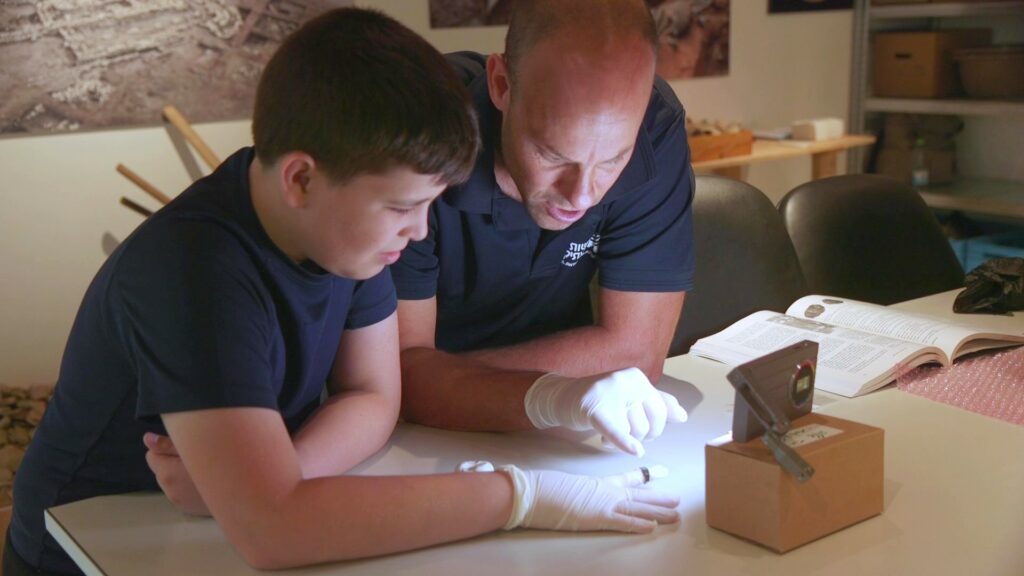In a remarkable find, 13-year-old Yair Whiteson of Haifa uncovered an 1800-year-old bronze ring during a hike with his father on Mount Carmel. The ring, engraved with an image of Athena, the Greek goddess of war, has been turned over to the Israel Antiquities Authority (IAA).

Dr. Eitan Klein of the Israel Antiquities Authority and Yair Whiteson examining the ring in the laboratories of the Jay and Jeanie Schottenstein National Campus for the Archaeology of Israel in Jerusalem. Photo: Emil Aladjem, Israel Antiquities Authority
Yair, an avid collector of fossils and rocks, spotted the small green object near the “ancient quarry” site below Khirbet Shalala. Initially mistaking it for a rusty bolt, he soon realized it was a ring bearing an intriguing image. The Whiteson family promptly contacted Nir Distelfeld, an Inspector at the IAA’s Theft Prevention Unit.
Upon examination by IAA experts and Prof. Shua Amorai-Stark from Kaye Academic College, the ring was identified as a Late Roman Period artifact, dating back to the 2nd-3rd century CE. The engraving depicts a helmeted naked figure, holding a shield and spear, believed to represent Minerva (Roman) or Athena (Greek), the goddess of war, military strategy, and wisdom.
Anat, a major northwest Semitic goddess of war, was heavily influenced by the character of the Greek goddess Athena. The ancient hero Shamgar, son of ‘Anat, is mentioned in Judges 3:31 and 5:6, which raises the idea that this judge or hero may have been understood as a demi-god, a mortal son of the goddess.
It is also believed that the Greek goddess Athena was based on the earlier Mesopotamian goddess Ashera and was later incorporated into early Islam as al-Lāt, worshipped in Saudi Arabia as the consort of Allah mentioned in the Koran. This would be consistent with the statue’s history at the site in Palmyra, which was used as a temple by the Mesopotamians, Romans, and Muslims in succession.
Dr. Eitan Klein from the IAA’s Unit for the Prevention of Antiquities Robbery explained that the ring likely belonged to a woman or girl. Its discovery site, near a Roman-era farmstead, remains, and ancient burial caves suggests various possibilities for its origin—perhaps owned by a local farmer, lost by a quarry worker, or left as a burial offering.

The ring. Photo: Emil Aladjem, Israel Antiquities Authority
The archaeological site, Khirbet Shalala, sits atop the Carmel Mountains, surrounded by Nahal Oren and near the perennial Ein Alon spring. Previously documented by 19th-century surveyors and renowned archaeologists, this new find adds another layer to the site’s rich history.
In recognition of his discovery and responsible reporting, Yair received a Good Citizenry commendation from the IAA. The ring will be displayed during IAA summer tours at the Jay and Jeanie Schottenstein National Campus for the Archaeology of Israel in Jerusalem, offering visitors a glimpse into Israel’s ancient past.
This discovery highlights the importance of public engagement in preserving archaeological heritage and the potential for significant finds in unexpected places. It also underscores the rich historical tapestry of the Mount Carmel region, continuing to yield insights into life during the Roman period in ancient Israel.






